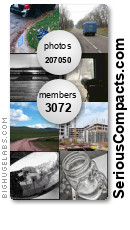After reviewing the official Sigma DP1 examples, my thoughts turned to the best method for upsizing them. While it is clear that these images contain a ton of detail, the choice of upscaling approach is important for getting the best possible extra large prints out of relatively small (4.65MP) files. As luck would have it, Ctein of The Online Photographer today posted Part 1 of a three-part comparison between Genuine Fractals, Blow Up, and Photoshop Bicubic. I'm looking forward to Parts 2 & 3, which are said to be coming over the next week.
In the meanwhile, I've been having fun experimenting with resizing approaches. In particular, I've been comparing Genuine Fractals and Photoshop Bicubic Smoother for their ability to upsize the DP1 samples to 14MP. The major problem I've encountered with upsizing the SD14 and DP1 files is that of aliasing artifacts (jaggies). Genuine Fractals seems to do an excellent job of preserving detail while minimizing these artifacts. I'm finding that the default setting on Genuine Fractals used to upsize followed by modest Smart Sharpening in PS (Amount 100, Radius 0.3) gives good results. In the comparison crops that follow, I compared this approach to Photoshop Bicubic Smoother, which required more aggressive subsequent sharpening (Smart Sharpen, Amount 200, Radius 1) for a similar degree of apparent detail. Disclaimers up front: 1) I don't yet have permission from Sigma to post upsized images, but I believe that using these tiny crops as examples is permissibile from a copyright standpoint. The original photographers for the images from which these crops were derived agreed with this; 2) JPEGs aren't the best source for upscaling. JPEG artifacts become more prominent; 3) Obviously my methods for upscaling may be suboptimal and therefore not representative of the DP1 X3 potential; 4) Rick Decker pointed out that the crop I chose from his image may not do justice to the sharpness possible with the DP1 given that the light wasn't that bright at the time of the capture.
Here are some examples (Click image for intended viewing size):

Another example (Click image for intended viewing size):

The differences are definitely subtle, and it would probably take quite a large print to show them. However, if you pick through looking for aliasing effects, they're present in the images resized using PS Bicubic to a greater extent than in those resized with GF5. The jaggies on the slope near the observatory are the most prominent example, but there are others if you look closely at 100%.
In a response to Ctein's article, Hugh Crawford posted the following insights regarding Genuine Fractals: "The behavior of the Genuine Fractals makes sense if you keep in mind that it was originally designed as a file compression program that converted the raster information to vector information and compressed it using wavelets. It tends to want to define things as areas with edges. On the one hand it does a good job of getting rid of aliasing effects on edges and sharpening them without the usual sharpening artifacts, but at the expense of wanting to make things look like areas with edges if the blur is near the sampling frequency." These comments agree well with my preliminary results shown above; and in examples not shown, I've seen a bit of the downside to which he referred.
I have written to Sigma for permission to feature upsampled images on this site. Depending on their reply, I will be able to more fully demonstrate the potential of this approach.
If you use the link below to join me in pre-ordering the DP1, Amazon will give me a small credit towards the purchase of my DP1. Thanks!
Upsizing Images
Wednesday, February 27, 2008
Posted by Amin
![]() Labels:
Bicubic,
Blow Up,
DP1,
Genuine Fractals,
Large prints,
Photoshop,
Resizing,
SD14,
Sigma,
TOP,
Upresing,
Upscaling,
Upsizing
Labels:
Bicubic,
Blow Up,
DP1,
Genuine Fractals,
Large prints,
Photoshop,
Resizing,
SD14,
Sigma,
TOP,
Upresing,
Upscaling,
Upsizing
Upsizing Images
2008-02-27T00:12:00-05:00
Amin
Bicubic|Blow Up|DP1|Genuine Fractals|Large prints|Photoshop|Resizing|SD14|Sigma|TOP|Upresing|Upscaling|Upsizing|
Subscribe to:
Post Comments (Atom)
Recent Posts
-
▼
2008
(254)
-
▼
February
(15)
- DC Watch Posts DP1 Samples and Model Shoot
- Sigma DP1 Added to Imaging Resource Comparometer
- Upsizing Images
- GEExtreme.com Posts DP1 Test Drive
- Sigma DP1 Official Image Samples Now Available.
- Interesting DP1 Comparisons Coming out of Korea.
- Your Input Needed for Sigma DP1 Shootout
- Sigma DP1 - 14MP or 4.6MP?
- Whisperingcat Photography: "The Great 14MP Shootout"
- Carl Rytterfalk "BW DP1 experiment" - Insights in...
- A YouTube History of Polaroid Instant Photography
- World Press Photo Contest 2008 Gallery
- This Week in Photography Podcast
- Photoborg.org
- Respect Fuji
-
▼
February
(15)

